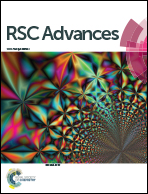Fabrication of PAM/PMAA inverse opal photonic crystal hydrogels by a “sandwich” method and their pH and solvent responses†
Abstract
This paper presents fabrication of polyacrylamide (PAM) and PAM/poly(methacrylic acid) (PMAA) inverse opal photonic crystal hydrogels (IOHs) based on poly(styrene-acrylic acid) (PSA) template by a “Sandwich” method. SEM images showed the obtained IOHs had a three-dimensional ordered structure and extremely uniform pore size without over-layers and defects. The IOHs exhibited brilliant structural color by controlling the PSA particle size, MAA and cross-linker compositions. The color and Bragg diffraction peak of the IOHs responded to external stimuli such as pH, methanol and ethanol. The reflectance was red-shifted in low pH and blue-shifted in high pH and in the presence of methanol and ethanol. The effects of the MAA and cross-linker composition on the response properties of the IOHs were investigated. The PMAA in the IOHs provided –COOH groups that are apt to form hydrogen bonds with water, enhancing the response sensitivity.


 Please wait while we load your content...
Please wait while we load your content...